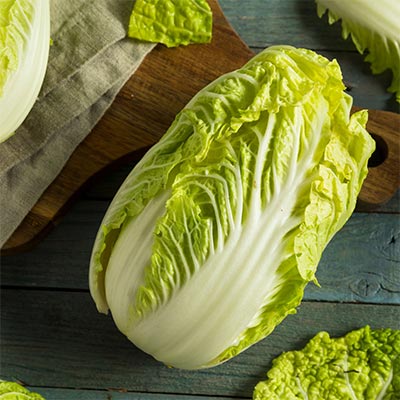 Napa cabbage is also known as Chinese cabbage.
Napa cabbage is also known as Chinese cabbage.
Background
- Napa cabbage is a member of the Brassicaceae botanical family which also consists of broccoli, cauliflower, bok choy, Brussel sprout, kale, turnip, and radish to name a few.
- Napa cabbage originated in China and is thought to be a natural hybrid evolved from a turnip and bok choy.
Nutrition
- 1 cup of cooked Napa cabbage is a good source of folate, copper, and manganese.
- Folate helps to prevent birth defects and assists in red blood cell formation and protein metabolism.
- Copper is an antioxidant which supports nervous system function, iron metabolism, and energy production.
- Manganese metabolizes carbohydrates, protein, and cholesterol while also aiding in wound healing and the formation of cartilage and bone.
How to Purchase, Prepare, and Store
- Purchase Napa cabbage at grocers year round.
- Choose medium sized Napa cabbages with firm leaves. They should be light green/yellow and heavy for their size. Avoid those with black spots, bug holes, or other blemishes.
- Prepare Napa cabbage by discarding any outer leaves that are wilted. Remove leaves individually and wash to remove any dirt hidden between the leaves. Use the leaves whole or shredded, depending on your recipe.
- Store unwashed in the refrigerator in a plastic bag.
- Eat Napa cabbage raw in salads, wraps, and slaws, or cooked in stir fries, soups, casseroles, or stews.
Nutrition Facts
1 cup Napa cabbage, cooked (109 g)
- Calories: 54.5
- Protein: 1.2 g
- Fat: 0.18 g
- Carbohydrate: 2.43 g
- Fiber: 1.7 g
- Calcium: 31.6 mg
- Iron: 0.8 mg
- Magnesium: 8.72 mg
- Phosphorus: 20.7 mg
- Folate: 46.9 µg
- Vitamin A: 14.2 µg
Via fdc.nal.usda.gov
Recipes
Request an Appointment